
Our three hour flight to Tokyo was uneventful. ANA's service was superlative as always, and we touched down on time. As it was late we had just enough time to call for a ride to our hotel in Narita before grabbing a quick bite and then hitting the sack. We were hungry and were told that there was food available on the 5th floor ... expecting a small cafeteria, we exited the elevator to be greeted by two of Japan's ubiquitous vending machines. After some consideration of our freeze-dried choices, we opted for a big and heavy package of self-heating curry rice.
Was it worth it? Definitely not. Although the food did indeed get very, very hot, our eight dollars only bought us a very small quantity of edible curry rice. The rest of our heavy package turned out to be just plastic, water, and lime. Such a clever design!
One great advantage of our teeny hotel room is that it came with free breakfast. We managed to get up early enough for a 6:30 am breakfast (hearty and satisfying after our disappointing vended curry rice) and a 7:00 bus to the airport/train station. On the way we talked with a very nice German tourist who was starting off on his own solo trip throughout Japan.
We departed on an express train to Nagano, with plans to continue further to Kamikochi. In Nagano we stood on a balcony of the train station overlooking the shiny clean mini-city of Nagano nestled in the mountains. The air smelled so clean after nine months in China, we just stood and breathed deeply for several minutes, enjoying the delicious taste and smell of the air. We hopped on a local train and at the end of the line, emerging at a bus station at the base of some of the peaks of the Japanese Alps. It was here that we had to make a crucial decision - should we take a bus to Kamikochi, recommended in our travel book but along with a warning that it can easily become overcrowded during the popular fall hiking season? Or should we go instead to Nori Kura, which only received a passing mention in our travel book but which we expected would be much less crowded? After watching a few groups of elderly Japanese tourists board the bus for Kamikochi, we made up our minds to try Nori Kura instead.
| Nancy consults our travel guide for more details on our choices. |  |
 |
Here's a minor peak of the Japanese Alps, as seen from the end-of-the-line train station. |
In Nori Kura we found that the temperature was about 20 degrees F lower than in the valley below; we donned our jackets and started off on a search for the Nori Kura youth hostel.
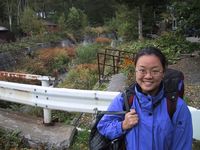 |
 |
Scenes from the beautiful mountainside hotspring village of Nori Kura.
After walking down a long long road winding its way into the trees, we found the youth hostel tucked up against the mountainside. It looked a little bit like a ski lodge. We asked the price and were astounded - $80 per night, no dinner, breakfast included. Whoah! We were used to youth hostels being cheap alternatives to hotels, on the order of $10 per night in other less afluent Asian countries - what was going on here?!? Later we would learn that we should have been thankful for such a low price by Japanese standards ...
What to do on a chilly fall evening in Nori Kura? The village seemed nearly completely deserted, with no other travellers anywhere to be found. We wanted to get away from the crowds, and we sure succeeded. Nori Kura was fantastically peaceful, with cool, clean mountain air, and friendly smiles wherever we ventured.
We stopped in at the local tourism bureau to ask if there was any place to eat dinner. Can you believe it - they didn't know of any restaurants open in Nori Kura that evening! The entire village was probably only a couple of dozen houses and buildings with a large selection of natural hotspring baths so I guess we shouldn't have been too surprised. We did manage to happen upon a restaurant on the main road that was very tasty. It had a very similar feel to a country roadside diner in the U.S.A. Who knows why the tourism bureau didn't know of their existence.
| The fog's rolling into Nori Kura ... time to head back to the youth hostel for a hot relaxing bath! |  |
Many parts of Japan have naturally occuring mineral hot springs, and Nori Kura is no exception. Hot spring baths are one of the attractions of the Nori Kura area and even our youth hostel had an indoor bath fed by the springs. The bather must shower off using the supplied soap, shampoo, and shower head before entering the bath. Japanese baths are kind of like nude hot tubs but the water is continually recycled as it drains off constantly while more water flows in. Additionally, it is against Japanese etiquette to enter a bath without scrubbing yourself clean first. But there were very few guests at the hostel and we were the only ones bathing (Nancy in the women's bath, Bryan in the men's) at that time.
| Bedding is provided in a closet attached to the room. Simple futon pads with sheets, comforters, and rice husk pillows make for a comfortable night's sleep. |  |
Nori Kura also features several hiking trails with waterfalls, and after a modest japanese-style breakfast we headed out for a hike. The weather was perfect - upper 60's, clear, and sunny.
 |
 |
No, it's not a real waterfall - it's just a pond by the side of the road. But it is pretty, isn't it? While we were taking these photos a Japanese man drove up and stopped in the middle of the road looking lost. He tried to ask us for directions (or so it seemed) but with absolutely no Japanese language skills whatsoever we were completely unable to help.
 |
 |
 |
Scenes from the hike.
| Finally we came to the waterfall. It didn't look that impressive. |  |
 |
 |
 |
Whoops - that wasn't the real waterfall! The real waterfall was behind us! Much better ... |
 |
 |
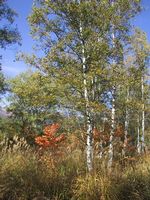 |
Early fall in the Japanese Alps. Magnificent!
 |
 |
 |
Eventually we came to a pretty tree-fringed pond with the mountains in the background. This was a very popular spot with the hikers/photographers/daytrippers, and several Japanese couples came and went, each toting huge cameras and tripod arrangements, which they dutifully set up to shoot dozens of photos of the pond. We did our fair share of shooting as these photos prove.
 |
 |
These panoramic photos demonstrate the natural beauty of the area.
| Here are some of the other tourists setting up their gear. |  |
After the pond we came upon a very strangely shaped tree. It had grown in a circular shape, twisting down towards the ground and then back up skywards again. Cool.
 |
 |
 |
 |
 |
We hiked back to the village and then decided to rent bicycles for a few hours and see more of the area. Our first stop was, of course, for lunch, at another Japanese roadside diner. We had a very confusing map provided by the local tourism bureau, and using it we managed to plot a broad course down the mountainside a ways and then back again.
When we reached the lowest point of our journey, after coasting peacefully among the trees along deserted back trails, we were just about to turn around to head back up again when we spotted a very unusual roadsign. It looked like a person with a croquet stick crossing the street. Then as we proceeded, we noticed some people in the woods playing something. Intruigued, we pressed onwards a bit further to discover an activity center with driving range, putt-putt golf course, and croquet golf course. We decided to try a round of croquet golf.
Croquet golf is just what you'd imagine it would be - golf played with a croquet stick and croquet balls instead of golf clubs and golf balls. The holes were all much shorter than normal golf holes - around 35 meters on average, but par was the same as in golf - 3, 4, or 5, depending upon the length, number of turns, hazards, green, and general difficulty of the hole. Because the holes were so short, and because croquet balls stay on the ground rather than flying in the air like golf balls, they were able to build an entire 27-hole course in the woods. The setting was beautiful. We enjoyed walking through the forest as we chased our balls from hole to hole.
 |
Nancy tees up at hole 1. |
| Bryan tries for par on hole 3. Soon after this he lost his ball, and had to get another one. Hmm...maybe they shouldn't have green balls. |  |
| Nancy brings the stick down hard to give her ball a solid whack. |  |
 |
 |
Not a bad setting for a bit of croquet golf, eh? |
| Bryan celebrates achieving par by juggling the croquet balls. |  |
 |
Do you think this mushroom was edible? We were hungry, but decided against having a nibble. |
| Japanese maples turn a beautiful crimson color in the fall. The trees and their leaves are much smaller than the North American variety. |  |
After our pleasant, but uninspirational, night at the youth hostel, we decided to try something a bit different and spend the night at a local pension, a european style bed and breakfast, for our second and last night in Nori Kura. We had some difficulty communicating with the man and woman who owned and ran the place, but eventually managed to secure one small, clean, bright, cheerful room with attached private bath including a western dinner and breakfast.
 |
 |
 |
 |
The B & B had two private, enclosed, outdoor baths in the rear garden - pure heaven after our long day of hiking and biking. Yes, it's true, no bathing suits required.
 |
Inside the B & B was a small entertainment room to keep us busy until it was time for dinner. |
| Bryan was just a little bit taller than the doorway to our room. |  |
 |
Here we are relaxing by the woodburning stove in the dining area before dinner. |
| The dining room was cozy and small but like all things Japanese, elegantly appointed and impeccably clean. |  |
 |
Appetizer - ??? Soup - ??? We missed a course somewhere in here ... |
 |
 |
The food was extremely well-prepared and we enjoyed the meal immensely. |
 |
Seafood salad thingy - ??? Dessert - ??? |
 |
The next day we left early to catch a bus to the Ogimachi, the next stop on our trip.
| Here's Nancy in front of our pension in the early morning light. |  |
The bus ride from Nori Kura to Ogimachi took us through Kamikochi, and after we had seen it we were even more convinced that Nori Kura was the right choice - even in the early morning it was teeming with tourists and the views were no more spectacular than at Nori Kura - perhaps less so because the mountains around Kamikochi are not lush with trees but instead are bare.
| The bus was about half full with elderly daytrippers, all decked out in their LL.bean collection (or Japanese equivalent) hiking gear. | 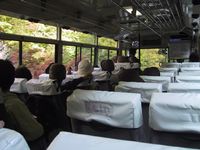 |
On the way to Ogimachi we had a several-hour layover so we decided to make the best of it by exploring this adorable little town.
 |
 |
We arrived in town at around lunch time, and there were many Japanese students walking around in groups on their lunch break. Nancy thought it was quite interesting that the female school girls wore leg warmers. Did they go out of fashion in the 80s?
 |
 |
Of course we immediately headed to the town market, which was situated on a small street that runs next to the river that winds through the center of town. There were lots of delicious-looking fruits and vegetables for sale so Nancy had a taste of one of the them. We weren't even sure what she was eating, but it was pretty tasty.
 |
 |
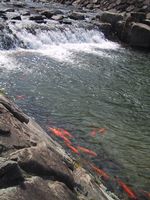 |
Since it was such a beautiful day we spent some time relaxing by the river and hanging with the koi.
There was a famous district of traditional Japanese homes, well preserved for several hundred years. We took our time exploring these neighborhoods as we searched for a good place to eat lunch. Many students were also wandering around these neighborhoods as well, and it was apparent that this was a popular destination for Japanese school field trips.
 |
The streets were very narrow and only very small Japanese sub-compact cars could fit through comfortably. In Japan there is quite an array of adorable compact vehicles. Wish they sold them here! |
 |
 |
 |
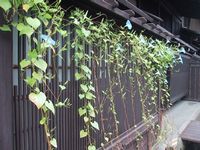 |
After a quick lunch at a local restaurant featuring "mountain vegetables" (which are mostly pickled and preserved ferns), we left for Ogimachi.
Back to: Fall 2001: Saying Goodbye to Beijing